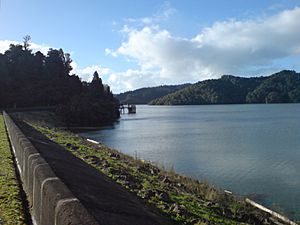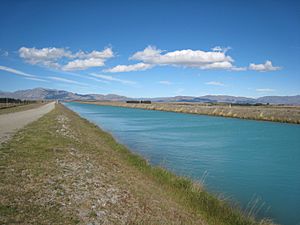List of dams and reservoirs in New Zealand facts for kids
New Zealand uses many large dams and reservoirs to create hydroelectricity. This means they use the power of moving water to make electricity. Dams and reservoirs are also important for watering farms (called irrigation) and supplying drinking water to towns and cities.
Making Electricity with Water: Hydro-electric Dams
Hydro-electric dams are like giant walls built across rivers. They hold back water, creating a large lake or reservoir. When water is released from the reservoir, it flows through big pipes. This fast-moving water spins turbines, which are like giant fans. The spinning turbines power generators that make electricity.
New Zealand has many hydro-electric dams. The biggest groups of dams are found on these rivers:
- The Waikato River
- The Waitaki River
- The Clutha River
Some other dams are built on their own, not as part of a big river system.
Tongariro Power Scheme
The Tongariro Power Scheme is a clever system. It moves water from the south side of Mount Ruapehu and the west and north sides of Tongariro. This water is sent into Lake Taupō. From there, it eventually flows into the Waikato River.
Key power stations in this scheme include:
- Rangipo (underground) (120 MW)
- Tokaanu (240 MW)
- Moawhango Dam
The Waikato River Dams
The Waikato River has a chain of hydro stations. They start from Lake Taupō and work their way down the river. Each station uses the water that has passed through the one before it.
Here are some of the main stations on the Waikato River:
- Aratiatia (84 MW)
- Ohakuri (112 MW)
- Atiamuri (84 MW)
- Whakamaru (100 MW)
- Maraetai (360 MW)
- Waipapa (51 MW)
- Arapuni (171 MW)
- Karapiro (90 MW)
The Waitaki River Dams
The Waitaki River system was built in many steps over time. The first dam was the Waitaki Dam. It was built without modern earthmoving machines. Later, the Aviemore Dam and Benmore Dam were added. Lake Pukaki was also dammed to store water and control its flow. A small power station was built at Lake Tekapo. Water from Lake Tekapo flows through a tunnel to a power station below the lake.
In the 1960s, work began on the Upper Waitaki project. This project created canals to move water between lakes and power stations. For example, water from Tekapo A station flows through the Tekapo Canal to Tekapo B station. The dam at Pukaki was made taller. Water from Lake Pukaki then goes into the Pukaki Canal. This canal joins the Ōhau Canal from Lake Ōhau. The water then flows through Ōhau A, B, and C stations.
Here are the stations in the Upper Waitaki project:
- Tekapo A (25 MW)
- Tekapo B (160 MW)
- Ōhau A (264 MW)
- Ōhau B (212 MW)
- Ōhau C (212 MW)
The original Waitaki power stations send water back into the Waitaki River. This river then becomes a storage lake for the next station.
These three power stations are:
A plan called Project Aqua was proposed to build six more dams on a man-made canal. However, this project was cancelled in 2004.
Clutha River Dams
The Clutha River in the South Island also has important hydro-electric dams:
- Clyde Dam (445 MW)
- Roxburgh Dam (320 MW)
Special Hydro-electric Schemes
Some hydro-electric schemes are unique because they don't rely on a high dam.
- Manapouri (850 MW)
Manapouri is special because it uses the natural height difference between Lake Manapouri and the sea. The power station is built inside a huge cave! Water flows from the lake through the power station. Then, it travels through two long tunnels, about 10 kilometers (6 miles) long, to Deep Cove in Doubtful Sound. A control structure helps manage the lake level.
Other Hydro Schemes
New Zealand has many other smaller hydro-electric schemes across both islands.
North Island
- Kaimai Scheme: A group of stations including Kaimai, Lloyd Mandeno, Lower Mangapapa, and Ruahihi.
- Aniwhenua Dam (25 MW) on the Bay of Plenty.
- Matahina Dam (36 MW) on the Rangitaiki River.
- Lake Waikaremoana Scheme: Three dams named Kaitawa, Tuai, and Piripaua.
- Wheao & Flaxy (26 MW)
- Hinemaiaia: Three small stations near Taupō.
- Motukawa (4.6 MW) and Mangorie (4.5 MW) in Taranaki.
- Patea Dam (31 MW) in Taranaki.
- Mangahao Dam (30 MW) in the Tararuas.
- Kourarau Scheme (1 MW) in Wairarapa.
South Island
- Waihopai (2.5 MW)
- Branch River: Includes Wairau & Argyle Stations (11 MW).
- Cobb Reservoir and Cobb Power Station (32 MW) in Golden Bay.
- Arnold Dam (3 MW) on the West Coast.
- Dillmans, Duffers, Kumara: A group of stations (total 47.9 GWh).
- Kaniere Forks (0.43 MW) & MacKays Creek (1.1 MW).
- Wahapo (3.1 MW) in South Westland.
- Lake Coleridge (45 MW) in Canterbury.
- Highbank (25.2 MW) and Montalto (1.1 MW – 1.8 MW) in Canterbury. These also help with irrigation.
- Opuha Dam (7.5 MW) in Canterbury, also used for irrigation.
- Paerau (10 MW) & Patearoa (2.25 MW) on the Taieri River, Otago. Also used for irrigation.
- Waipori: Four dams near Dunedin.
- Monowai (6 MW)
- Roaring Meg: Two power stations (1.3MW, 3MW).
Dams for Drinking Water: Municipal Water Supply Dams

These dams create reservoirs that store water for people to drink. This water is treated to make it safe before it reaches homes.
Auckland's Water Dams
Auckland, New Zealand's largest city, gets its water from several dams, mostly in the Hunua Ranges.
- Cosseys Dam
- Hays Creek Dam
- Upper Huia Dam
- Lower Huia Dam
- Mangatangi Dam
- Mangatawhiri Dam
- Upper Nihotupu Dam
- Lower Nihotupu Dam
- Waitākere Dam and Reservoir
- Wairoa Dam
Other North Island Water Dams
- Clapcott Concrete Arch (Gisborne No. 1) Dam - Gisborne
- Kaitoke Weir and Macaskill Lakes – Upper Hutt
- Mangamahoe Dam - New Plymouth
- Okehu Stream/Waitahinga Dam - Whanganui
- Upper and Lower Turitea - Palmerston North
- Whau Valley Dam and Wilsons Dam – Whangarei
South Island Water Dams
- Waitohi (Barnes) Dam - Picton
- Maitai Dam - Nelson
- Opuha Dam – Canterbury, also used for hydro-electricity.
- Ross Creek Reservoir – Dunedin
- Sullivan's Dam – Dunedin
Dams No Longer in Use (Defunct)
Some dams that once supplied water are no longer used for that purpose. They might be part of nature reserves now.
- Birchville Dam – Upper Hutt
- Johnsonville Waterworks - Ohariu Valley
- Korokoro Dam
- Morton Dam - Wainuiomata
- Upper and Lower Karori Dams and the Karori Reservoirs – Wellington (now a nature reserve)
- Teviot Dam - Roxburgh
Dams for Farming: Irrigation Dams
Irrigation dams store water that is used to water crops and pastures on farms. This helps plants grow, especially in dry areas.
- Lakes Manuwai and Waingaro at Kerikeri: These dams were built specifically for irrigation.
- Opuha Dam: This dam is used for both irrigation and making electricity.
See also



